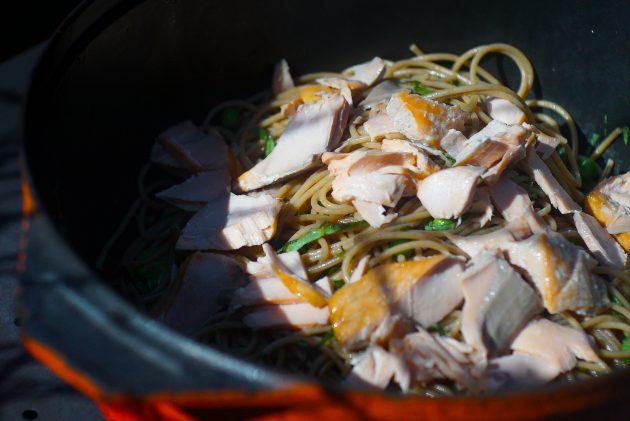Elite sports chef Omar Meziane tells us just how versatile seafood can help the serious athlete. Bootcamp comes in association with Alaska Seafood.
Advertising Feature
Harness the protein power of wild seafood after rugby training
When it comes to looking after your body, many rugby players crave routine. However, while this can help in terms of conditioning, rehab and sleep, it can prove quite dull in the kitchen.
“I think we in the UK – and bearing in mind, we’re an island – are slightly nervy about how to cook fish and how to make it delicious,” says Omar Meziane, chef with Harlequins and England.
According to Meziane, who is also co-author of Cooking for Fitness, alongside James Haskell, many of us have been put off eating fish from a young age. And these people are now missing out on a valuable source of protein.
So he has teamed up with Alaska Seafood for their Fuel Your Fitness campaign to let athletes know that there are more interesting ways to replenish the body, away from the usual suspects on your plate.
Meziane continues: “Fish is far more versatile than chicken as a whole, you know. So I think it has been undersold. We should definitely have more of it in this country.
“I work incredibly closely with nutritionists and if they want (players) to eat a high-protein diet, they may also be looking for the added goodness of the fish, so the Omega 3, selenium, and so on. Essentially, it’s my job to turn that fish into something delicious and appealing.

Meet the chef: Omar Meziane (pic via Alaska Seafodd UK)
“Chicken is obviously incredibly lean, very high in protein, you know, but the added benefits that we can get from fish far outweigh that of chicken, in particularly seafood from Alaska which is incredibly lean because of its wild nature and premium quality with it being frozen at sea.”
Below, Meziane gives us his recipe for Wild Alaska Salmon Katsu Curry. But do the elite rugby players eat that much fish?
“Take the really heavy training day we recently had with Harlequins, for instance,” he says. “Breakfast on a day like that would be generally quite light, you know, lots of oats to power them through those beasts of sessions. Lunch is then that perfect time to get the fish in.
“It would generally be a piece of salmon which is popular, or a meaty whitefish such as Alaska pollock or yellowfin sole, perhaps. A lot of the boys when they come off the training pitch are exhausted. They don’t necessarily want to eat anything that’s too heavy. However, they know as part of their job they’ve got to eat and eat the right things.
“So if we can present them with a piece of wild salmon, for instance, full of protein, full of healthy oils and fats and it’s delicious, it is going to do the job for them. It’s going to help them with that recovery in between sessions.”
You may have noticed Omar’s delicious-looking salmon spaghetti above, or the recipe below.
Want a bit more inspiration? You can visit Alaska Seafood’s recipe site and why not check out @AlaskaSeafoodUK on Twitter.

Firm favourite: Delicious: Wild Alaskan Katsu Curry (pic by Markus Dell)
Omar’s Wild Alaska Salmon Katsu Curry
Serves 2
“Katsu Curry is a firm favourite with most Brits and the rugby boys I cook for are no exception,” says Meziane. “Whenever I make this meal for them, they just can’t get enough of it. It’s a super easy dish to make and you can add rice if you fancy it, making the dish a high-carb option.
“Perfect for a post workout meal, the omega 3 fatty acids can help towards the reduction of post exercise muscle inflammation. Wild salmon from Alaska is also packed with lean protein which is essential for muscle repair.”
Ingredients:
2 wild Alaska salmon fillets, skin removed 160g-180g
2 eggs
50g plain flour
Salt and pepper
100g panko breadcrumbs
50ml neutral vegetable oil
For the katsu sauce
400g chopped tomatoes
400ml coconut milk
1 tbsp mild curry powder
3 tbsp dark soy sauce
1 tbsp honey
1 lemongrass stalk
2 red chillies
½ white onion
1 tbsp coconut oil
Method:
- Pre-heat your oven to 180°
- Finely chop the onion and chillies for the sauce and bash the lemongrass with the back of a knife. Heat a large deep saucepan over a medium heat and add the coconut oil. Add the onion, chilli and lemongrass and cook without colouring for 1-2 minutes. Now add the curry powder, coconut milk, chopped tomatoes, soy sauce and honey. Bring the sauce to the boil and then turn down to a gentle simmer and cook for 15 minutes. Once the sauce is cooked remove the lemongrass, check the seasoning and set aside.
- Place the flour into one bowl, crack and whisk the eggs into a separate bowl and place the breadcrumbs into another bowl. Place the salmon fillets into the flour and cover all over, then dip the salmon into the egg mixture, coating all over. Finally, into the breadcrumbs, ensure the breadcrumbs are covering the salmon fillets. Once the salmon fillets are bread-crumbed set aside for 5 minutes.
- Heat a large sauté pan over a medium heat and add the vegetable oil, once the oil is hot add the salmon fillets one at a time and cook for 1-2 minutes on each side or until golden brown. Once the salmon fillets are sealed, place them onto a roasting tray and pop into the oven for 8 minutes or until cooked through. Once the salmon is cooked place onto 2 serving plates and serve the sauce alongside or pour over the salmon.
This piece is in association with Alaska Seafood. You can follow them on Twitter at @AlaskaSeafoodUK.
Don’t forget to follow Rugby World on Twitter, Facebook and Instagram.





